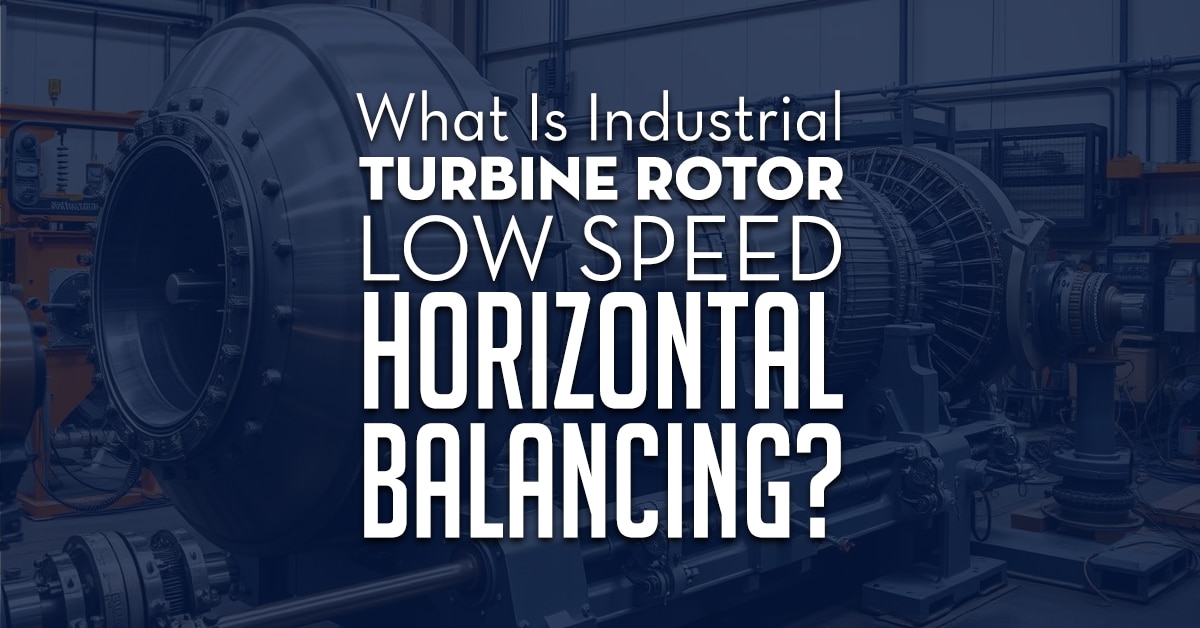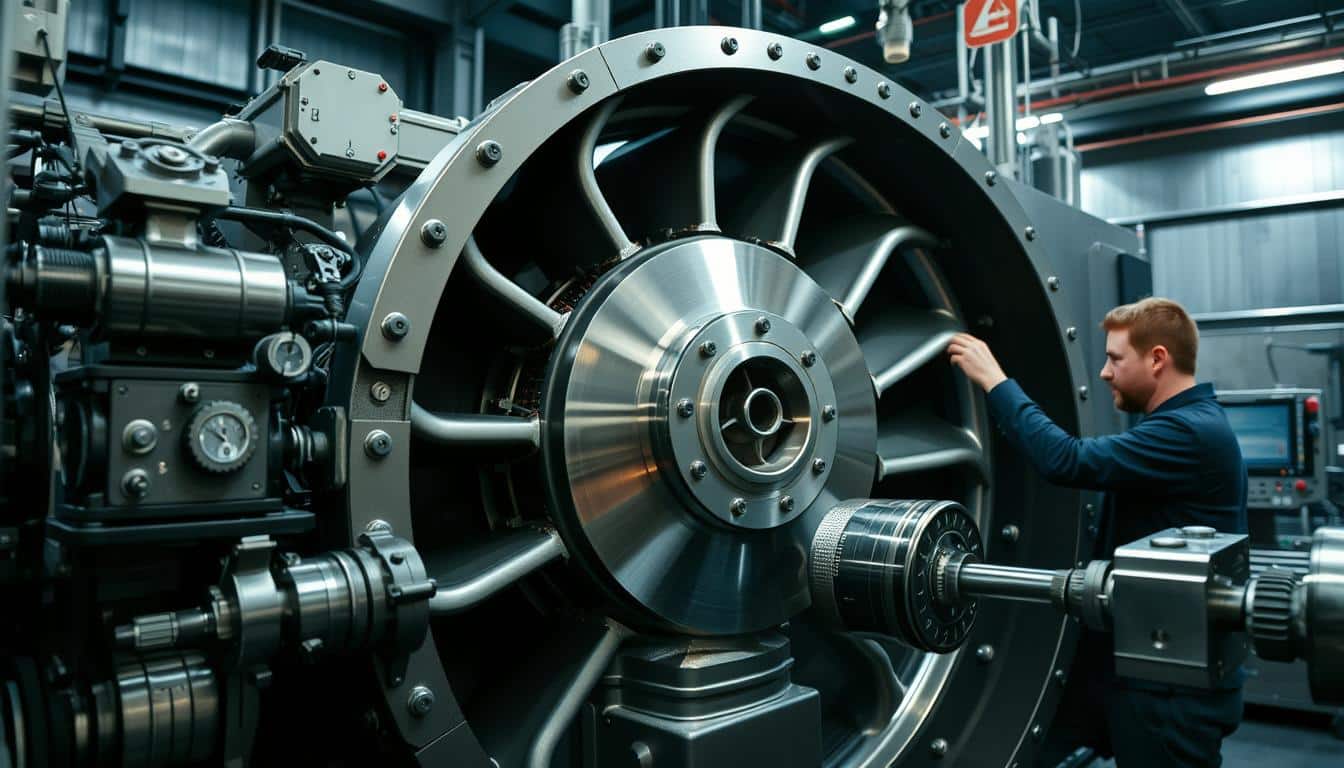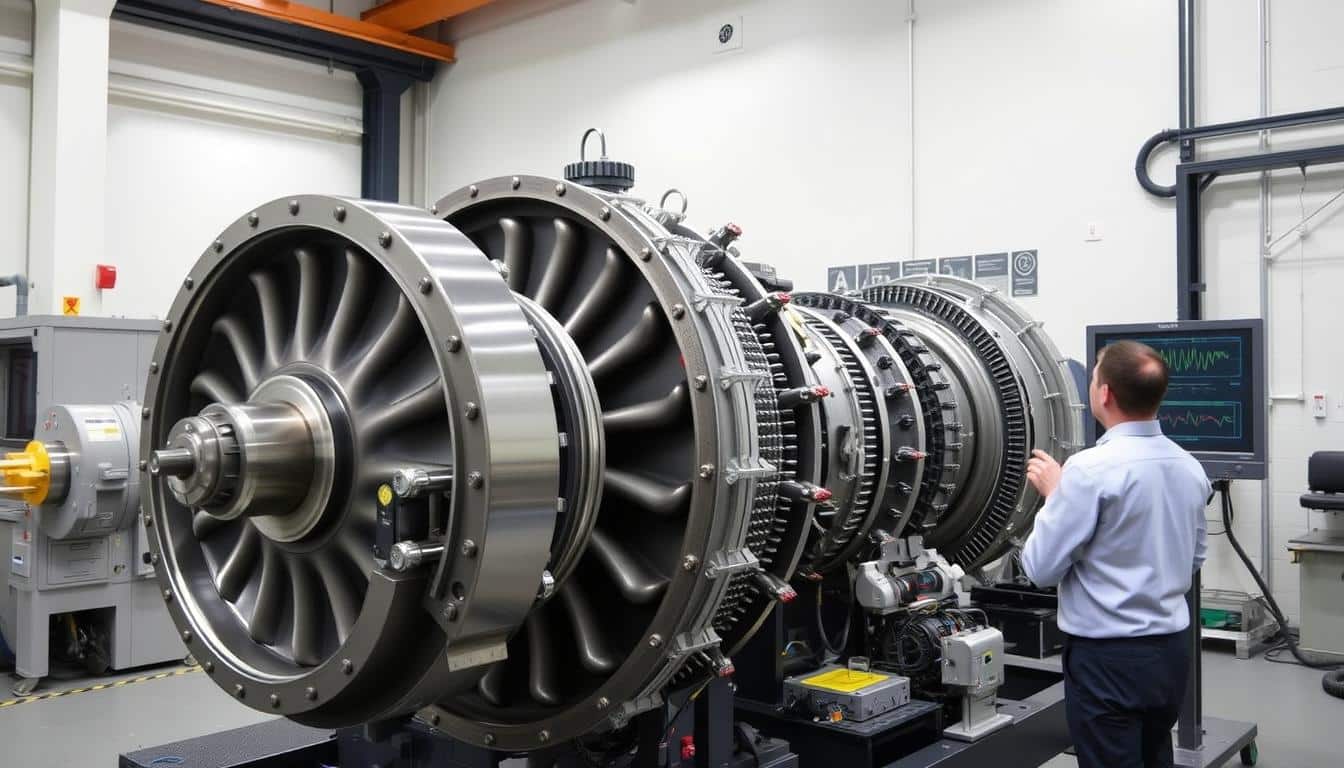Unlocking Precision: What Is Industrial Turbine Rotor Low-Speed Horizontal Balancing?
When it comes to industrial turbine repair, low-speed horizontal balancing is key. It enhances turbine performance, cuts down on vibration, and boosts equipment longevity. Allied Power Group, a Houston, Texas-based leader in industrial turbine repair, excels in this technique. We ensure precise rotor equilibrium.
Industrial turbines, complex machines, rely on smooth component rotation for efficiency. Imbalances arise when the machine’s center of rotation doesn’t match its center of gravity. These can stem from the customer’s production process. Such imbalances cause excessive vibration, performance drops, and can lead to early turbine failure.

Low speed horizontal balancing corrects these imbalances, returning the turbine rotor to its best state. Technicians measure and adjust mass distribution around the rotor’s spin axis. This ensures bearing forces and vibrations meet ISO 1925 standards. Specialized balancing machines and techniques are used to pinpoint and fix imbalances accurately.
The significance of low speed horizontal balancing is immense. Unbalanced rotors can cause noise, efficiency drops, and even catastrophic failures. These failures lead to costly downtime and repairs. Precision balancing techniques, like low speed horizontal balancing, enhance turbine reliability, safety, and performance. They also reduce downtime and maintenance expenses.
Key Takeaways
- Low speed horizontal balancing is essential for optimizing industrial turbine performance and extending equipment lifespan.
- Imbalances occur when a turbine’s center of rotation differs from its center of gravity, often due to factors related to the production process.
- Unbalanced rotors can lead to excessive vibration, reduced efficiency, and premature failure of the turbine.
- Precision balancing techniques, such as low speed horizontal balancing, help correct imbalances and restore the rotor to its optimal state.
- Properly balanced turbines offer improved reliability, safety, and performance, while reducing downtime and maintenance costs.
Introduction
In the realm of power generation and industrial applications, the smooth operation of turbines is essential. Industrial turbine balancing is key to this, correcting rotor imbalances caused by uneven mass. These imbalances can cause excessive vibrations, reduce efficiency, and damage equipment if not addressed.
Low-pressure turbines require specific balancing techniques due to their larger, more rigid rotors. By minimizing vibrations and optimizing performance, balancing ensures the reliability and longevity of these critical assets.
What is Industrial Turbine Balancing?
Industrial turbine balancing is a specialized process aimed at identifying and correcting rotor imbalances. These imbalances can stem from manufacturing tolerances, material imperfections, or wear over time. The goal is to distribute centrifugal forces evenly, reducing vibrations and improving performance.
Importance of Balancing in Industrial Turbines
Balancing is vital for several reasons:
- Reducing vibrations: Excessive vibrations can cause premature wear on bearings, seals, and other components, leading to increased maintenance costs and downtime.
- Improving efficiency: An unbalanced rotor can result in energy losses, reducing the overall efficiency of the turbine and increasing operational costs.
- Enhancing safety: Severe imbalances can potentially lead to catastrophic failures, posing a significant risk to personnel and equipment.
By addressing these issues, industrial turbine balancing contributes to the reliable and efficient operation of power generation and other industrial applications.
Overview of Low-Speed Horizontal Balancing
Low-speed horizontal balancing is a technique used in industrial turbines, focusing on larger, more rigid rotors in low-pressure stages. This method involves rotating the rotor assembly at a lower speed than its operating speed, typically on horizontal balancing machines. Vibration analysis is performed to identify the magnitude and location of imbalances, allowing for targeted corrections to be made.
Why This is Important to Industrial Operations
Effective industrial turbine balancing is essential for maintaining the performance, reliability, and safety of critical assets in power generation and other industrial applications. By minimizing vibrations and optimizing efficiency, balancing helps to:
- Prolong equipment lifespan
- Reduce maintenance costs and downtime
- Enhance operational efficiency
- Ensure the safety of personnel and equipment
Investing in regular balancing procedures, such as low-speed horizontal balancing, is a proactive approach to asset management. It yields significant long-term benefits for industrial operations.
Fundamentals of Industrial Turbine Balancing
Industrial turbines, like gas turbine rotors and steam turbines, are vital in power generation and manufacturing. They convert mechanical energy into electrical power, making their efficient operation key for productivity. Minor imbalances in these turbines can cause major problems, requiring strict balancing techniques.
Understanding Rotational Imbalance
Rotational imbalance happens when the center of mass doesn’t align with the axis of rotation. This can be due to manufacturing defects, uneven wear, or deposits on the rotor. The centrifugal force from an imbalance is the product of mass (m) and radius (r). This imbalance causes vibration at a frequency equal to the rotational speed, known as 1x. For instance, at 1200 RPM, this vibration occurs at 20 Hz.
The magnitude of unbalance is mass (m) times radius (r), measured in g-mm. When the unbalance exceeds specified tolerance, as per balancing standards like ISO 21940-11, correction is needed. The effect of unbalance can be understood by comparing it to the rotor’s weight, using a normalized form.
The Impact of Imbalance on Performance and Efficiency
Imbalance significantly affects the performance and efficiency of industrial turbines. Unbalanced rotors cause increased vibrations, leading to excessive wear on bearings, seals, and other components. This wear can reduce output, increase energy consumption, and even cause equipment damage. In extreme cases, imbalance can result in catastrophic failures.
To prevent these risks, various balancing techniques are used, including single-plane balancing, low speed balancing, and dynamic balancing of gas turbines. These methods ensure industrial turbines operate smoothly and efficiently. They extend the turbines’ lifespan and lower maintenance costs. By maintaining optimal balance, power plants and manufacturing facilities can boost productivity and reduce downtime.
Types of Balancing Techniques in Industrial Turbines
Balancing is key for the smooth operation of industrial turbines. Precision balancing ensures that rotating parts, like rotors and shafts, are evenly balanced. This minimizes vibrations and reduces wear on machinery. There are two main balancing techniques: static and dynamic balancing.
Static Balancing
Static balancing ensures the rotor’s weight is evenly distributed around its axis. It’s used for narrow wheels or disc-shaped components. The goal is to align the center of gravity with the center of rotation. This technique is vital in applications like bike wheels, grindstones, and car wheels. It keeps the object stationary on a horizontal axis without needing external braking force.
“Balancing of rotating bodies is critical to prevent catastrophic failures in heavy industrial machines like gas turbines and electric generators.”
Dynamic Balancing
Dynamic balancing addresses the moments of out-of-balance weights along the axis about the bearings. It’s used for rotating systems that produce resultant centrifugal forces or couples. This method requires a spinning mechanism, a frame for perpendicular vibration, and a system to detect imbalance via vibration measurements. One-plane dynamic balancing involves attaching weights near a rim to minimize vibration. Two-plane balancing is used for rod-like objects, fixing the spin axis of one end while allowing vibration at the other.
Low-Speed vs. High-Speed Balancing
The choice between low-speed and high-speed balancing depends on the application and rotor type. Low-speed rotor balancing is for larger, more rigid rotors, like those in low-pressure turbines and steam turbine rotors. These are balanced using horizontal balancing machines at lower speeds. High-speed balancing is for more flexible rotors and is done at higher speeds, closer to the turbine’s operating speed.
Allied Power Group offers a range of balancing services, including low-speed and high-speed balancing. They use state-of-the-art horizontal balancing machines. Their experienced team provides single-plane and multi-plane balancing. This ensures industrial turbines operate smoothly and efficiently, extending equipment lifespan and reducing maintenance costs.
Low-Speed Horizontal Balancing – An Overview
Low-speed horizontal balancing is a method to reduce unbalance in industrial turbines. It shifts the center of mass to the axis of rotation. This process aims to lower vibrations and enhance performance, mainly for large, rigid rotors in low-pressure spindles. It involves adding compensating weights to counteract the effects of unbalanced masses, as theory supports for rigid rotors.
Definition and Core Principles
Horizontal balancing is done in two or three planes, addressing both translational and couple (rocking) rigid body modes. The balancing effect changes with rotational frequency, influenced by aerodynamic and electromagnetic forces. Balancing becomes more complex with narrow rotors, requiring larger correction weights due to significant “induced imbalance.
Why Horizontal Balancing is Used For Industrial Turbines
Industrial turbines operate at high speeds, making balancing essential for performance and longevity. A dynamically unbalanced rotor can exert unpredictable forces on bearings, not captured by static balance measurements. The costs of unbalanced centrifugal forces can be much higher than expected, affecting bearing life. Low-speed horizontal balancing addresses these challenges in industrial turbines.
Properly balanced rotor vibration amplitude at 3000 RPM is just over 8 mm/sec, while at a reduced speed of 2200 RPM, the vibration amplitude is 1.4 mm/sec.
Advantages of Horizontal Balancing
Horizontal balancing brings several benefits to industrial turbines. It counteracts rigid body forces and moments, reducing vibrations and boosting performance. The balancing program targets a specific balance quality grade, like G1.5 (8 grams) at 700 RPM. Modular designs and ergonomic features make operation efficient, eliminating the need for calibration runs.
The Mechanics of Low-Speed Horizontal Balancing
Low-speed horizontal balancing is vital for the smooth operation of industrial turbines. It involves several key components and steps. These ensure balance, reducing vibration and wear on equipment.
Key Components Involved
The main parts include the rotor, bearings, and balancing machine. Rotors can be as heavy as 400,000 lbs. Precision balancing aims for tolerances of 0.0007 ounce-inches.
Soft-bearing machines are more sensitive at low speeds. Hard-bearing machines operate at higher speeds due to their force measurement method.
How the Balancing Process Works
The process starts with measuring the initial unbalance with vibration sensors. Then, weights are added or removed on the rotor to counteract the unbalance. This step may need to be repeated several times.
Modern machines allow for high-precision balancing. They reduce the need for trial-and-error methods.
Dynamic balancing techniques are used in low-speed balancing. They adjust an object’s weight by adding or removing mass while rotating at a set speed. This method significantly reduces vibration, improving smooth operation and minimizing noise.
Single plane dynamic balancing is suitable for components with widths less than 30% of their diameter. Multiplane dynamic balancing is used for wider components, essential for high-speed rotors.
Rotor balancing is critical to ensure proper operation and reduce vibration. Unbalanced rotors can cause increased wear, reduced lifespan, and breakdowns. Accurate low-speed balancing leads to lower energy costs and fewer machinery failures, boosting operational efficiency.
At APG, our experts know the importance of precision balancing in industrial turbines. Contact us to learn more about our low-speed horizontal balancing services. We can help optimize your equipment’s performance.
Key Benefits of Low-Speed Horizontal Balancing
Low-speed horizontal balancing brings numerous advantages to industrial turbines, ensuring they perform at their best and last longer. It identifies and fixes vibration problems early, thanks to balancing throughout the rotor assembly. This proactive maintenance extends equipment life, boosts efficiency, and increases safety.
Prolonged Equipment Lifespan
One key benefit is the longer life of equipment. By reducing vibrations, rotors wear down less, preserving bearings and other critical parts. This leads to less mechanical stress, extending the life of turbines and saving costs over time.
Improved Operational Efficiency
Dual-plane balancing optimizes rotor performance at its rated speed. This method ensures rotors run efficiently, cutting energy use and boosting system performance. Efficient operation means lower energy bills and fewer breakdowns, increasing productivity and profits.
Reduction in Downtime and Maintenance Costs
Regular low-speed rotor balancing cuts downtime and maintenance costs. It catches and fixes imbalances early, preventing costly repairs or shutdowns. This approach keeps turbines running smoothly, saving on maintenance and boosting efficiency.
Enhanced Safety and Reliability
Balancing aims to boost efficiency, safety, and reliability. Properly balanced rotors reduce vibrations, easing stress on components. This makes the work environment safer and reduces failure risks. Modern balancing equipment’s high-speed features ensure accurate measurements and corrections, further improving turbine reliability.
Summary
Low-speed horizontal balancing is key for improving industrial turbine performance and longevity. It tackles rotational imbalance and reduces vibrations, leading to balanced rotors. This ensures less wear and tear, boosting overall system efficiency. Grasping rotor balancing principles and using advanced techniques are vital for maintaining high efficiency in rotating machines.
The advantages of low-speed horizontal balancing are significant. It extends equipment life by reducing vibrations tied to mass distribution. This method also cuts downtime and maintenance costs, as balanced rotors handle higher speeds with less bearing stress. It also increases safety and reliability by reducing vibration-related issues, whether the rotor is rigid or flexible.
Allied Power Group, with its vast experience and cutting-edge rotor balancing methods, offers complete solutions for industrial needs, including power plants. Their experts take precise readings at the two bearings and make accurate corrections to vibrations. This ensures optimal balance and performance. Allied Power Group excels in torsional vibration analysis and adheres to balancing standards, providing the perfect solution for maintaining peak efficiency in rotating machinery across various industries.
Low-speed horizontal balancing is essential for optimizing industrial turbine performance and reliability. It leverages rotor dynamics to ensure smooth operation as electrical energy flows through these systems. By tapping into the expertise of companies like Allied Power Group and understanding rotor balancing, industries can achieve high efficiency, extended equipment life, and enhanced safety in their rotating machines.
Frequently Asked Questions
What is industrial turbine balancing?
Industrial turbine balancing corrects imbalances in the rotor due to uneven mass distribution. This can cause excessive vibrations, reduce efficiency, and lead to equipment damage. It ensures optimal performance and efficiency in power generation and other industrial applications.
Why is low-speed horizontal balancing important for industrial turbines?
Low-speed horizontal balancing is vital for maintaining optimal performance and efficiency in industrial turbines. It’s essential for larger, more rigid rotors like those in low-pressure turbines. This technique addresses rotational imbalance, minimizes vibrations, and ensures smooth operation. It leads to extended equipment lifespan and reduced maintenance costs.
What causes rotational imbalance in industrial turbines?
Rotational imbalance occurs when the center of mass does not align with the axis of rotation. This imbalance can be caused by manufacturing defects, wear, or deposits on the rotor. It leads to vibrations and reduced efficiency.
What are the main types of balancing techniques for industrial turbines?
The main balancing techniques are static and dynamic balancing. Static balancing ensures even weight distribution around the shaft’s axis. Dynamic balancing addresses the moments of out-of-balance weights along the axis about the bearings.
How does low-speed horizontal balancing work?
Low-speed horizontal balancing minimizes residual unbalance by shifting the center of mass to the axis of rotation. It involves measuring the initial unbalance with vibration sensors. Then, weights are added or removed at specific locations on the rotor to counteract the unbalance. This process is carried out in two or three planes and addresses both translational and couple (rocking) rigid body modes.
What are the benefits of low-speed horizontal balancing for industrial turbines?
Low-speed horizontal balancing offers numerous benefits. It prolongs equipment lifespan, improves operational efficiency, reduces downtime and maintenance costs, and enhances safety and reliability. Properly balanced rotors experience less wear and tear, leading to extended bearing and equipment life.
What equipment is used for low-speed horizontal balancing?
Low-speed horizontal balancing involves the rotor, bearings, and balancing machine. Modern balancing machines, such as those used by Allied Power Group, allow for high-precision balancing. They minimize the need for trial-and-error methods.
How can low-speed horizontal balancing contribute to predictive maintenance strategies?
Low-speed horizontal balancing addresses rotational imbalance and minimizes vibrations. It maintains balanced rotors, reduces wear and tear on components, and improves overall system operation. This technique contributes to predictive maintenance strategies, ensuring high levels of efficiency and safety in industrial turbines.

